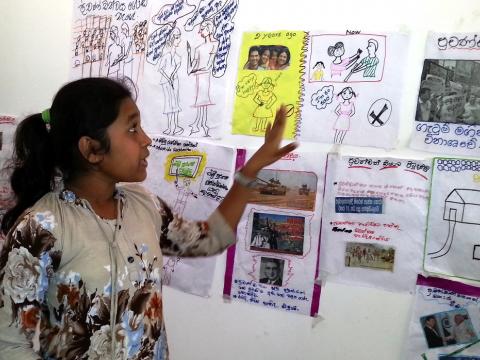Participation of boys and girls in addressing gender-based violence

By Patricio Cuevas-Parra, Senior Policy Adviser, Child Participation and Rights, Advocacy and Justice for Children, WVI.
The Convention on the Rights of the Child (CRC) explicitly states that children have the right to be protected from all forms of violence and guarantees this right under Articles 19, 28 and 32.[1] The CRC defines violence in Article 19 as ‘all forms of physical or mental violence, injury and abuse, neglect or negligent treatment, maltreatment or exploitation, including sexual abuse’.[2]
Gender-based violence is violence inflicted or suffered as a result of gender differences. This terminology is broadly used to refer to violence against women; however, a new wave of researchers and practitioners have embraced the concept of gender-based violence to also include any violence that affects children based on their gender or as a result of structures, institutions and cultures that reinforce and perpetuate patterns of violence against children (VAC).[3]
The United Nations (UN) study on VAC defined five settings in which children spend time and may consequently experience violence, including home or with family, school, care and justice systems, workplaces and the community. These settings are not isolated environments, and issues of violence can occur in multiple settings simultaneously, especially when children live in particularly vulnerable situations. The study also points out that vulnerabilities are linked to a child’s age, race, ethnicity, disability, social status or gender.[4]
Girls and boys can experience similar types of violence in multiple settings; however, depending on the circumstance, they may face different issues as a result and violence may be exacerbated based on gender-specific factors. For instance, research shows that trafficked children are exploited in different ways as boys are made to beg and girls are forced into prostitution. In armed conflicts, boys are forcibly recruited into armed groups and girls are abducted and exploited sexually or for domestic labour[5].
In order to respond to gender-based violence, it is critical to analyse VAC with a gender lens to identify the gender-related issues that affect boys and girls differently. Neglecting to acknowledge the existence of gender-based VAC continues social norms and stereotypes indefinitely and leaves the root causes unaddressed.
Evidence shows that it is essential to increase knowledge and awareness about how gender issues impact VAC and promote the participation of boys and girls in the solutions[6]. Sustainable changes to end VAC must ensure the meaningful engagement of boys and girls and take their voices into account. As an example of that practice, the UN study on VAC established that one of the fundamental principles to ending VAC is to provide spaces and opportunities for children and young people to express their views, giving them due weight in the planning and implementation of violence prevention policies and programmes. Furthermore, the study emphasised in its seven overarching recommendations that member states should actively engage with children and young people and respect their views in all aspects of prevention, response and monitoring of violence against them. Moreover, the study argued that child- and youth-led initiatives are pivotal in addressing violence as they can contribute their own views and experiences to interventions to stop violence against them.[7]
[1] United Nations General Assembly Session 44 Resolution 25, Convention on the Rights of the Child (20 November 1989).
[2]—, ‘Article 19’, in Convention on the Rights of the Child (20 November 1989).
[3] Houghton, C. (2015) Young People’s Perspectives on Participatory Ethics: Agency, Power and Impact in Domestic Abuse Research and Policy Making, Child Abuse Review, 24(2), pp235–248.
[4]Pinheiro, P. (2006) United Nations Secretary-General’s Study on Violence against Children.
[5]—, ‘Article 19’, in Convention on the Rights of the Child (20 November 1989).
[5]Lewis, C. (2011) A preliminary study on child trafficking In Lebanon: Patterns, perceptions and mechanisms for prevention and protection. World Vision Lebanon.
[6] Överlien, C. and Hydén, M. (2009) Children’s actions when experiencing domestic violence, Childhood, 16(4), pp479–496.
[7]Pinheiro, P. (2006) United Nations Secretary-General’s Study on Violence against Children.